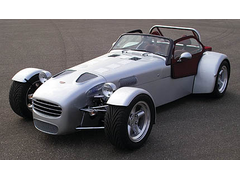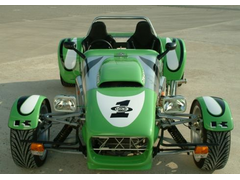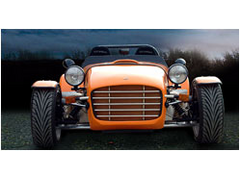Alfalfameister
|
| posted on 14/7/06 at 02:15 PM |

|
|
Donkervoort "look" and stance
I'm not sure if this belongs to the chassis forum, but it's worth a try:
I really like the Donkervoort look. It has an aggressive looking stance.
How does it achieve that look? I tried looking at some pics, but I'm not seeing it.
Is it lower than a regular book chassis? I know it's a bit wider, but I've seen a wider car (Luego), and it still didn't have that
aggressive look.
Or is it just the bodywork that makes the difference?
I'm not sure, but the Lotus/Locost looks like it narrows more from the body towards the nosecone (vis-a-vis the Donkervoort), whereas the
Donkervoort keeps it rather straight(er).
If that is correct (more straight rather narrowing towards the nosecone), is there a reason why the standard book and original Lotus narrow towards
the front (functionally speaking)? Or was the narrowing/tapering more an aesthetic reason?
[Edited on 14/7/06 by Alfalfameister]
|
|
|
|
|
AdamR
|
| posted on 14/7/06 at 02:28 PM |

|
|
The tapered front is more to do with providing room for the suspension than anything else.
I think it's probably the bodywork that makes the Donkervoort stand out from the crowd.
[Edited on 14/7/06 by AdamR]
|
|
|
kreb
|
| posted on 14/7/06 at 02:41 PM |

|
|
Please post a pic of the Donkevoort you mean. There's a bunch of models, and some look very average.
That said, wide and low always looks tough. Throw wide tires on anything and it looks more menacing.
https://www.supercars.net/blog/wp-content/uploads/2016/04/1966_FiatAbarth_1000SP1.jpg
|
|
|
t.j.
|
| posted on 28/7/06 at 08:30 PM |

|
|
quote:
Originally posted by kreb
Please post a pic of the Donkevoort you mean. There's a bunch of models, and some look very average.
That said, wide and low always looks tough. Throw wide tires on anything and it looks more menacing.
I think he ment this one:
 
d8
One thing for sure: It is expensive.
De Nose-cone is different, the drivers-compartment is wider. the rear track is wider about 147 cm front about 140 cm. Max. wide is 173 at the rear.
Has a Audi-engine. The windscreen is not flat. etc. etc
And it is above my budget....
[Edited on 28/7/06 by t.j.]
|
|
|
leto
|
| posted on 30/7/06 at 07:32 AM |

|
|
Mainly, the Donkervoort uses much taler wheels than a locost. The top of the front wings are almost as high as the nosecone. The locost chassis is
designed for 13” wheels, using taller wheels will give you a SUV-class ground clearance or some trouble with the front suspension. From what I can
see in pictures, the Donkervoort uses uprights with a high wheel center. If you want to use tall wheels I recommend you to use a redesigned chassis.
The body is designed to look long and low with short cockpit and a rounded bonnet. The rear wings are rather narrow and the shoulders are leaning
slightly to make them cover more of the body. Too wide rear wings will make a se7en look flat IMHO. The sides of the windscreen are leaning inwards an
the roll bar is low.
Cheers!
[Edited on 06-7-30 by leto]
“I'm gonna ride around in style
I'm gonna drive everybody wild
'Cause I'll have the only one there is a round”. (J. Cash)
|
|
|
kreb
|
| posted on 30/7/06 at 02:32 PM |

|
|
Pardon my ignorance here, but how will taller wheels affect the chasis and suspension beyond greater unsprung weight, higher cg, and even worse
aerodynamics? You're making it sound as though the geometry's going to be buggered up.
https://www.supercars.net/blog/wp-content/uploads/2016/04/1966_FiatAbarth_1000SP1.jpg
|
|
|
Dale
|
| posted on 30/7/06 at 03:54 PM |

|
|
Using taller whees or centers would change your camber reaction or wheel geometry. It would cause your lower arms to point upwards which if not
compensated in the design will cause unwanted reactions. Mine point somwhat up but that area has been set as the sweetspot for both camber change
and bump steer. Rasiing the lower brackets up would help but the uppers would have to adjusted as well to maintain the proper geometry.
Dale
Thanks
Dale
my 14 and11 year old boys 22
and 19 now want to drive but have to be 25 before insurance will allow. Finally on the road
|
|
|
Deckman001
|
| posted on 30/7/06 at 04:23 PM |

|
|
I'd guess it was a lot to do with the size and rake of the windscreen 
Jason
|
|
|
leto
|
| posted on 30/7/06 at 07:15 PM |

|
|
Just want to specify what Dale say a little 
Wheel size will directly affect scrub radius and trail, taler wheels often makes them better. If you lower the body to compensate the taler wheels
some suspension parameters, like virtual swing arm and camber change at roll, will change to the worse, at least on a locost. The changes are not big
but the car will have some less grip. Limitations of suspension travel in shocks and joints might also be a problem. And of course there's the
drawbacks that kerb mention.
“I'm gonna ride around in style
I'm gonna drive everybody wild
'Cause I'll have the only one there is a round”. (J. Cash)
|
|
|
cita2
|
| posted on 30/7/06 at 08:39 PM |

|
|
The nose cone is longer and deeper at the front.The double grill makes it even look deeper and more agressive.
The curved windscreen and wide rear wings make it complete.
Replace the windscreen with a square locost one and a "regular" nosecone and the Donkervoort looks more like a Locost than you should
think
Cita
[Edited on 30/7/06 by cita2]
|
|
|
kreb
|
| posted on 31/7/06 at 12:58 AM |

|
|
quote:
Using taller whees or centers would change your camber reaction or wheel geometry. It would cause your lower arms to point upwards which if not
compensated in the design will cause unwanted reactions. Mine point somwhat up but that area has been set as the sweetspot for both camber change and
bump steer. Rasiing the lower brackets up would help but the uppers would have to adjusted as well to maintain the proper geometry.
I can see how force is applied somewhat differently when cornering or going over a bump, but at rest, your lower A arm is going to be the same angle
whether your tires are 10" or 10 foot. Yes?
https://www.supercars.net/blog/wp-content/uploads/2016/04/1966_FiatAbarth_1000SP1.jpg
|
|
|
TheGecko
|
| posted on 31/7/06 at 03:16 AM |

|
|
quote:
I can see how force is applied somewhat differently when cornering or going over a bump, but at rest, your lower A arm is going to be the same
angle whether your tires are 10" or 10 foot. Yes?
Not neccesarily. A 13" wheel with say a 185/60 tyre on it has an overall diameter of 552mm (~21.75" ). A 15" wheel with 195/55
tyre (what I'm using) is 596mm (~23.5" ). That difference in diameter means that the axle line and hence the upright and balljoints all
sit 20-25mm higher - the equivalent of lowering the car 20-25mm. So either you raise the car by an inch or accept that you've "used
up" an inch of suspension travel or you change the suspension layout to allow for the fact. My middy-clubman uses Holden Gemini (Chevette)
uprights which have the ball joints about 30mm higher, relative to the axle line, than a Cortina. Add that to the larger rolling diameter and I have
a front suspension layout that's no longer much at all like a Locost.
Does that make it any clearer or just muddy the waters more? 
Dominic
|
|
|
Lippoman
|
| posted on 31/7/06 at 05:32 AM |

|
|
quote:
I can see how force is applied somewhat differently when cornering or going over a bump, but at rest, your lower A arm is going to be the same
angle whether your tires are 10" or 10 foot. Yes?
Only if you go for a 5'1" higher ground clearance with the taller tires...
|
|
|
Alfalfameister
|
| posted on 3/8/06 at 11:47 AM |

|
|
quote:
Originally posted by snoopy
 i think its the wider track and nosecone that does it heres a mk indy with a donker nosecone looks pretty mean wouldnt you agree i think its the wider track and nosecone that does it heres a mk indy with a donker nosecone looks pretty mean wouldnt you agree 
I agree! 
|
|
|
locostv8
|
| posted on 3/8/06 at 06:39 PM |

|
|
quote:
Originally posted by TheGecko
quote:
I can see how force is applied somewhat differently when cornering or going over a bump, but at rest, your lower A arm is going to be the same
angle whether your tires are 10" or 10 foot. Yes?
Not neccesarily. A 13" wheel with say a 185/60 tyre on it has an overall diameter of 552mm (~21.75" ). A 15" wheel with 195/55
tyre (what I'm using) is 596mm (~23.5" ). That difference in diameter means that the axle line and hence the upright and balljoints all
sit 20-25mm higher - the equivalent of lowering the car 20-25mm. So either you raise the car by an inch or accept that you've "used
up" an inch of suspension travel or you change the suspension layout to allow for the fact. My middy-clubman uses Holden Gemini (Chevette)
uprights which have the ball joints about 30mm higher, relative to the axle line, than a Cortina. Add that to the larger rolling diameter and I have
a front suspension layout that's no longer much at all like a Locost.
Does that make it any clearer or just muddy the waters more? 
Dominic
Or you properly locate your suspension pickup points depending on the tire/wheel used.
What the larger diameter tire will give you is a larger contact patch (better traction).
[Edited on 3/8/06 by locostv8]
http://wrangler.rutgers.edu/gallery2/v/7slotgrille/hssss/
|
|
|
DIY Si
|
| posted on 3/8/06 at 08:00 PM |

|
|
quote:
What the larger diameter tire will give you is a larger contact patch
Oh no it won't. What it will do is change the shape of the contact patch. The size is the same regardless of tyre/wheel choice. It's the
shape that alters. It can vary from a long thin shape with skinny wheels to short and wide with wide wheels. Ideally, I think, yu want the contact
patch to be slightly longer than it is wide. This should give the best compromise between lateral and longditudinal grip.
|
|
|
locostv8
|
| posted on 3/8/06 at 08:10 PM |

|
|
quote:
Originally posted by DIY Si
quote:
What the larger diameter tire will give you is a larger contact patch
Oh no it won't. What it will do is change the shape of the contact patch. The size is the same regardless of tyre/wheel choice. It's the
shape that alters. It can vary from a long thin shape with skinny wheels to short and wide with wide wheels. Ideally, I think, yu want the contact
patch to be slightly longer than it is wide. This should give the best compromise between lateral and longditudinal grip.
OH yes it will. Note I said larger diameter TIRE/TYRE. A difference in rim diameter will have minimal effect on contact patch but tire diameter will
have an effect on contact patch.
The rear tires I'm using on my Locost are 315 35 17 which have a tread width of 12.5 and a diameter of 26". Compare that to a 195 60 15
with a tread width of 6.2" and a diameter of 24.2. I guarantee at the same air pressure and appropriate sized rims thet the 315 will have over
twice the contact patch.
[Edited on 3/8/06 by locostv8]
http://wrangler.rutgers.edu/gallery2/v/7slotgrille/hssss/
|
|
|
rocket
|
| posted on 6/8/06 at 09:48 AM |

|
|
umm
I think you guy's mean to argue over the width of the tyre no dia.
Anyhow I've done some research into this one as I too like the donk. Also the dax rush and Dax's bike engined lightweight version.
Critical factors are size of wheel As I see it the "beefy" looking cars have the top of the wheel level with the bonnet and a wider track (
or smaller nose) Also ( I have my own expression for this) Is the "frog" eyed" look. This is the place where the Lights are mounted and
to some extent the size.
The "bad" or in my eyes less desirable look is big light mounted high up big ground clearance with wishbones pointing down and tall bonnets
also fat noses and short wishbones I'l show you some pics see if you guys agree.
 
Rescued attachment kawasaki_2a.jpg
|
|
|
rocket
|
| posted on 6/8/06 at 09:50 AM |

|
|
and this one
I'd say good looking
 
Rescued attachment 1.jpg
|
|
|
rocket
|
| posted on 6/8/06 at 09:53 AM |

|
|
Beef
I do like this caterham I think because if the lights
Rgds
Roger
|
|
|
rocket
|
| posted on 6/8/06 at 10:04 AM |

|
|
beef
A bad un!!!
Fat bonnet short wishbones and lights too high.
Rgds
Roger
 
Rescued attachment viento1.jpg
|
|
|









